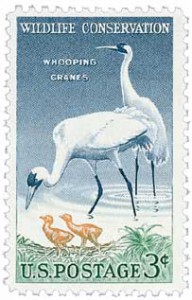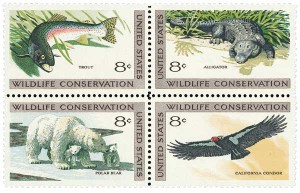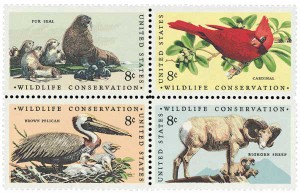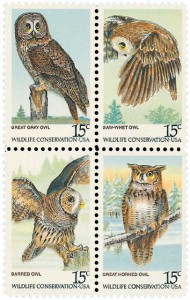
On May 5, 1956, the US Post Office issued the first stamp in a 22-year series calling attention to the importance of wildlife conservation.
Initially, the series began in 1956 with three separate stamps honoring examples of successful conservation work carried out by the federal and state governments.
The first stamp in the series honored the wild turkey. It was issued on May 5, 1956, at the convention of the Wisconsin Federation of Stamp Clubs, in Fond du Lac, Wisconsin. The wild turkey, the largest and fastest of the game birds, was selected for this stamp because of the successful work in restoring the birds to their native homes in eastern, southwestern, and middle western states.
The second stamp in the series was issued on June 22, 1956, at the annual convention of the Izaak Walton League in Gunnison, Colorado, an environmental organization founded in 1922. The league promotes the protection of natural resources, as well as outdoor recreation. The pronghorn antelope was selected for this stamp because it too has benefitted from conservation efforts. Before the arrival of European settlers, the pronghorn population was an estimated 25 million. By 1920, that number had fallen to about 17,000. Conservation efforts helped the pronghorn antelope increase to approximately half a million today.
The third stamp was issued on November 9, 1956, in Seattle, Washington in collaboration with the Salmon Industry of the Northwest. The stamp pictures the king salmon, also known as the Chinook salmon. Great efforts have been made to preserve salmon populations and the environment they need to survive. Pollution has been reduced and fish ladders allow the fish to cross dams and other man-made obstacles. Improved hatcheries produce thousands of healthy salmon to restock rivers and lakes.
On November 22, 1957, the post office added the fourth stamp to the series honoring whooping cranes. First Day ceremonies were held in Corpus Christi, Texas; New York, New York; and New Orleans, Louisiana. Early American explorers reported whooping cranes in 35 US states, with numbers now estimated between 700-1,400. By 1941, only 21 whooping cranes were alive in the US. In 1937, whooping crane wintering grounds were protected in Texas by the creation of the Aransas National Wildlife Refuge. Located on the East Coast of Texas, north of Corpus Christi, the safety provided by Aransas helped the migratory population grow from 14 to over 200. Every living whooping crane in America today is descended from the 15 found in Texas in 1941.
It would be more than 10 years before the USPS issued another stamp in the series. The next stamps were issued on June 12, 1971, in Avery Island, Louisiana. This time it was a block of four stamps honoring threatened and endangered species. The polar bear, the California condor (one of the rarest birds in the world) and the alligator have all been threatened with extinction. Increased water pollution has also put several species of trout in jeopardy.
The series continued the following year with the sixth issue on September 20, 1972, in Warm Springs, Oregon. While the Alaska fur seal, the cardinal, and the brown pelican are not necessarily endangered, in the mid-1970s, there were fewer than 20,000 bighorn sheep. This issue points out the fact that wildlife conservation should be a major concern.
The final issue in the series came on August 26, 1978, in Fairbanks, Alaska. The block of four featured the American owl. It pictures the great grey owl, the largest of owls, and the saw-whet owl, which is one of the smallest. The barred owl can hoot to sound like a barking dog, and the great horned owl is an aggressive predator that will attack any animal up to the size of a goose.
Click here for more animal stamps.
| FREE printable This Day in History album pages Download a PDF of today’s article. Get a binder or other supplies to create your This Day in History album. |
Discover what else happened on This Day in History.








Great job Mystic. We have a pair of barred owls that reside on our property and enjoy seeing and hearing them. We also see wild turkeys quite frequently and that is only in the last twenty years. I am thankful that conservation efforts started years ago and feel more attention and support should be given.
United Europe has caught up with BIRDS preservation theme since last year, starting with Russia with an app (mARka) for smart phones of a stamp of mama CRAIN with its chick and when this stamp is viewed under the app shown in the above bracket (you’ll need to download it first for FREE), it takes off in the air, makes three circles in the sky and lands back in the lake. Amazing and beautiful concept never had seen before. This year several European countries have been issuing stamps of birds from their land -some migratory. However, Jersey is the one that has released (last month) a set of six bird stamps by its famous artist TWO OF WHICH SING when viewed under a smart phone ‘CEE App’. Modern technology taking postage stamps to a new high and many more to be seen in the near future. As far as US is considered, it released some bird/animal stamps that have a hidden message which can be read with a special lens (not free) and get this: YOU CAN’T EVEN PURCHASE SUCH A LENS EVEN FRO MYSTIC STAMPS (sold out -is their answer). I guess, USPS may have assumed that usage of a postage stamp is seeing its imminent death ……. sorry to say this but on the contrary it keeps on issuing beautiful commemorative collectible FOREVER STAMPS that my nearby post office DOES NOT CARRY. Got to purchase by visiting USPS.COM for the same – USING COMPUTER? Get the point!
really cool stamps